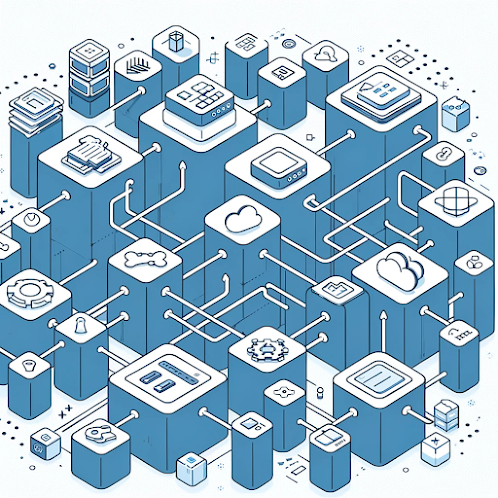Microservices architecture has emerged as the go-to framework for constructing modern, scalable, and robust software applications. By decomposing an application into small, manageable services, organizations can achieve unprecedented levels of agility and resilience. Let's delve into the essential components and design principles that underpin a robust microservices architecture, providing practical examples and paving the way for a deeper exploration of deployment and security in a forthcoming article.
Load Balancers and Service Registry: Balancing the Load with Precision
In a microservices ecosystem, load balancers play a critical role in distributing incoming network traffic across multiple servers. This distribution ensures that no single server bears too much load, which can prevent overloading and contribute to the system's resilience. Load balancers can also facilitate a smooth service registry mechanism, allowing services to register themselves and discover other services dynamically. With health probes and checks, load balancers ensure that traffic is only sent to healthy service instances, further promoting system availability.
The service registry is the backbone of service discovery in a microservices architecture. It keeps track of all service instances and their locations, making it possible for services to call each other without hardcoding the hostnames and ports. This dynamic registration and deregistration of services, as they come online or go offline, allows for high flexibility and automation within the system.
API Gateways and BFF APIs: Tailored Access Points
The API Gateway is a single entry point for all clients. It's responsible for request routing, composition, and protocol translation. With the increasing complexity of systems, the gateway encapsulates the internal structure of the system and exposes API endpoints for different client apps. It is essential for managing security concerns such as authentication and authorization, rate limiting, and analytics.
A specialized version of the API gateway is the Backend for Frontend (BFF) pattern, where a separate backend is tailored for each type of client - mobile, web, or desktop. This allows for custom logic that can consolidate and optimize data for the needs of each client, providing an experience that is best suited to the client's requirements.
Communication Patterns in Microservices
Communication between services in a microservices architecture can be synchronous or asynchronous.
Synchronous communication is straightforward: a service waits for a response before moving on. This is often implemented using HTTP/REST, but it can create a tight coupling between services and reduce overall system resilience.
Asynchronous communication leverages message brokers or event buses to implement a "fire-and-forget" model, where a service sends a message and does not wait for a direct response. This pattern is central to building responsive systems that can handle variable loads and can continue to function even if some components fail.
API Style and Standards for Microservices: The Linguistics of Services
For API design, REST (Representational State Transfer) is the most popular choice due to its statelessness and cacheability, aligning well with microservices principles, with HTTP verbs (GET, POST, PUT, DELETE) as the grammar rules. For instance, a RESTful API enables a user to retrieve a product list (GET), add a new product (POST), update product details (PUT), or remove a product (DELETE). However, alternative styles like GraphQL and gRPC offer different advantages, such as more efficient data loading and operation-specific interfaces.
Resiliency Patterns: The Safety Nets
Resilience is the ability of a system to handle and recover from failures. Several patterns contribute to the resilience of microservices, such as:
Timeouts prevent the system from waiting indefinitely for a response.
Circuit breakers stop calls to a service if failures reach a threshold, allowing it to recover.
Retry patterns involve making repeated attempts to execute an operation, ideally with some delay between attempts.
OpenAPI and API Catalogue: The Blueprint
Effective communication and documentation are vital. OpenAPI Specification (OAS) provides a language-agnostic way to document APIs, which helps in creating clear contracts between services. It can also facilitate the generation of API documentation and SDKs for various programming languages.
Eventual Consistency and Event-driven Architecture: The Symphony of Services
Microservices often rely on an event-driven architecture to propagate changes and maintain eventual consistency across the system. This is achieved by publishing events whenever data changes, allowing other services to react to these changes asynchronously. This model supports better performance and scalability but requires careful design to handle out-of-order events and failures.
Event-driven architecture is akin to a symphony orchestra: when the percussion section (one service) strikes a beat (changes data), the string section (another service) responds in harmony (updates its data), leading to eventual consistency across the orchestra (the entire system). This decoupled approach allows for flexibility and scalability.
Transaction Management
Managing transactions across microservices can be complex. Traditional ACID transactions are challenging to implement due to the distributed nature of services. Instead, the saga pattern is often used, where each business transaction is broken into a series of local transactions, each with its own compensating transaction to undo changes if necessary.
These components and patterns form the backbone of a robust microservices architecture. Understanding and implementing them correctly is crucial for building scalable, resilient, and maintainable systems. Each pattern comes with its trade-offs and should be chosen based on the specific needs and context of the application being developed. As microservices continue to evolve, these principles remain central to fostering innovation and agility in software development.
Conclusion and Look Ahead
In summary, microservices architecture is a complex interplay of various components and patterns that work together to create scalable, resilient, and maintainable systems. By understanding and implementing these core principles, organizations can navigate the challenges of modern software development with confidence.
In the upcoming article, Let's shift our focus to the critical aspects of deployment strategies and security considerations in a microservices architecture. Stay tuned for "Part Two: Deploying and Securing Microservices," where lets dissect the nuances of rolling out microservices to production and ensuring they are fortified against threats.
